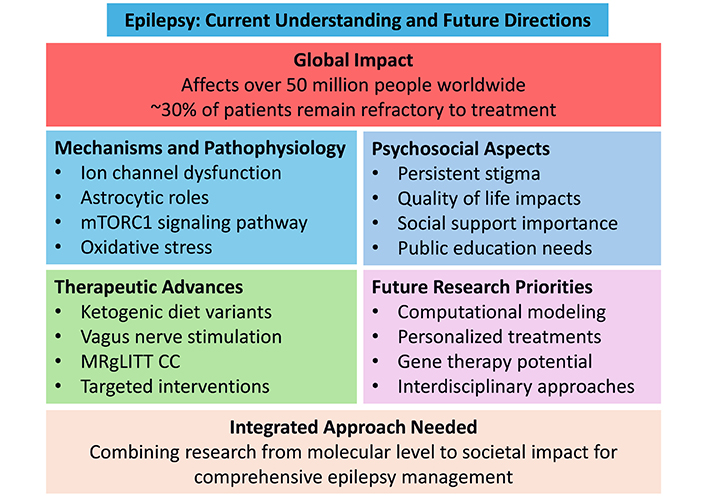Affiliation:
1Hatherly Laboratories, Institute of Biomedical and Clinical Sciences, College of Medicine and Health, University of Exeter Medical School, Exeter EX4 4PS, UK
2State Key Laboratory of Bioorganic & Natural Products Chemistry, Research Center of Chemical Kinomics, Shanghai Institute of Organic Chemistry, Chinese Academy of Sciences, Shanghai 200032, China
Email: j.zhang5@exeter.ac.uk
ORCID: https://orcid.org/0000-0001-8683-509X
Explor Neurosci. 2025;4:100670 DOl: https://doi.org/10.37349/en.2025.100670
Received: December 13, 2024 Accepted: December 20, 2024 Published: January 15, 2025
Academic Editor: Dirk M. Hermann, University of Duisburg-Essen, Germany
The article belongs to the special issue Epilepsy
Epilepsy, a complex and widespread neurological disorder, has evolved in its understanding from ancient misconceptions to modern scientific advancements. This special issue highlights pivotal research and reviews on the mechanisms underlying epilepsy, innovative treatment strategies, and the psychosocial dimensions of living with this condition. Together, these contributions reflect the growing interdisciplinarity and depth in epilepsy research.

Epilepsy, affecting over 50 million individuals globally (WHO), has historically been misunderstood [1], often seen through the lenses of superstition and stigma. Modern research has reframed epilepsy as a neurological disorder characterized by recurrent seizures due to abnormal brain activity [2]. While antiepileptic drugs (AEDs) effectively manage seizures for many patients, approximately 30% remain refractory to treatment, necessitating novel therapeutic approaches [3].
This special issue of Epilepsy within the journal of Exploration of Neuroscience features five original research articles and five comprehensive reviews, offering readers cutting-edge insights into epilepsy’s pathophysiological mechanisms, emerging treatments, and psychosocial challenges. Below, we synthesize the key contributions.
Banerjee and Jirsa [2] provide a multiscale analysis of epilepsy, moving from cellular-level ion channel dysfunctions and astrocytic roles to whole-brain network dynamics. They emphasize the transformative potential of computational modeling for predicting seizures and personalizing treatments. Yamashita et al. [4] further illuminate the role of somatostatin-expressing inhibitory neurons in cortical layers 4/5, identifying mTORC1 signaling as a critical pathway in epileptogenesis. Their findings open avenues for targeted interventions.
Žerovnik’s review [5] on progressive myoclonus epilepsies (PMEs) delves into molecular underpinnings like oxidative stress and mitochondrial dysfunction, with a focus on Unverricht-Lundborg disease. The exploration of gene therapy and autophagy-enhancing treatments underscores the potential for innovative therapeutic strategies.
The ketogenic diet (KD), discussed by Vityala et al. [6], continues to show promise for refractory epilepsy, particularly in pediatric populations. This review evaluates variations of the KD, such as the modified Atkins diet, offering insights into balancing efficacy with patient compliance.
Gonzalez-Fernandez et al. [7] introduce a novel platform for transcutaneous vagus nerve stimulation (tVNS), showcasing its efficacy in reducing seizure frequency in drug-resistant epilepsy. Their pilot study underscores the importance of integrating artificial intelligence and patient-specific protocols for optimizing outcomes. Sheikh et al. [8] highlight the role of magnetic resonance-guided laser interstitial thermal therapy corpus callosotomy (MRgLITT CC) as a minimally invasive option for managing refractory epilepsy, particularly in complex pediatric cases.
Ricke’s study [9] examines adverse events (AEs) related to epilepsy following vaccinations. While most vaccines show no significant association, certain formulations exhibit elevated risks, particularly in infants and children with conditions like Dravet syndrome. These findings call for refined vaccination protocols and further investigations into potential manufacturing contaminants such as endotoxins.
Yeni’s review [10] focuses on the persistent stigma associated with epilepsy and its impact on quality of life. Despite medical advancements, societal misconceptions continue to hinder patients’ social and psychological well-being. This is echoed in Walker and Peterson’s longitudinal study [11], which underscores the importance of robust social support systems in improving outcomes for people with epilepsy (PWE).
Choque-Velasquez et al. [12] provide a comprehensive review of epilepsy in patients with arteriovenous malformations (AVMs). Their work highlights the prevalence of seizures, diagnostic challenges, and treatment options like microsurgical resection and stereotactic radiosurgery, emphasizing the need for tailored strategies to optimize outcomes.
The contributions in this special issue highlight significant advancements in understanding epilepsy’s complexities. Yet, they also underscore the need for continued interdisciplinary research—from elucidating molecular mechanisms to addressing societal challenges. The integration of computational models, targeted therapies, and public education campaigns offers a comprehensive pathway to enhancing the lives of individuals living with epilepsy.
By fostering dialogue and collaboration among researchers, clinicians, and policymakers, we can ensure that the next decade of epilepsy research is transformative. This special issue of Epilepsy within the journal of Exploration of Neuroscience stands as a testament to the progress made and the potential yet to be realized in the field.
KD: ketogenic diet
JZ: Writing—original draft, Writing—review & editing.
Jinwei Zhang is the Editorial Board Member and Guest Editor of Exploration of Neuroscience had no involvement in the decision-making or the review process of this manuscript.
Not applicable.
Not applicable.
Not applicable.
Not applicable.
This work was supported by The Royal Society UK [Grant no. IEC\NSFC\201094], and the National Natural Science Foundation of China [Nos. 82170406 and 81970238]. The funders had no role in study design, data collection and analysis, decision to publish, or preparation of the manuscript.
© The Author(s) 2025.
Open Exploration maintains a neutral stance on jurisdictional claims in published institutional affiliations and maps. All opinions expressed in this article are the personal views of the author(s) and do not represent the stance of the editorial team or the publisher.
Copyright: © The Author(s) 2025. This is an Open Access article licensed under a Creative Commons Attribution 4.0 International License (https://creativecommons.org/licenses/by/4.0/), which permits unrestricted use, sharing, adaptation, distribution and reproduction in any medium or format, for any purpose, even commercially, as long as you give appropriate credit to the original author(s) and the source, provide a link to the Creative Commons license, and indicate if changes were made.
View: 662
Download: 40
Times Cited: 0
Srilaxmi Vityala ... Swathi Nenavath
Joham Choque-Velasquez ... Alder Fernando Valenzuela-Rangel
Rene Ivan Gonzalez-Fernandez ... Jose Luis Hernandez-Caceres
Kabir Sheikh ... Jeffrey Raskin
Eva Žerovnik
Christine Walker, Chris L. Peterson
Swati Banerjee, Viktor Jirsa
Darrell O. Ricke
Fumiki Yamashita ... Mari Wataya-Kaneda
